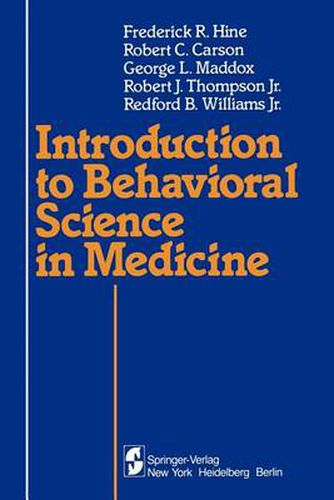Readings Newsletter
Become a Readings Member to make your shopping experience even easier.
Sign in or sign up for free!
You’re not far away from qualifying for FREE standard shipping within Australia
You’ve qualified for FREE standard shipping within Australia
The cart is loading…






This title is printed to order. This book may have been self-published. If so, we cannot guarantee the quality of the content. In the main most books will have gone through the editing process however some may not. We therefore suggest that you be aware of this before ordering this book. If in doubt check either the author or publisher’s details as we are unable to accept any returns unless they are faulty. Please contact us if you have any questions.
This book is the product of many years’ experience teaching behavioral science in a way that demonstrates its relevance to clinical medicine. We have been guided by the reactions and evaluations of many first-year medical students. The result is a conceptual framework different from those that we and others had tried before. Because the clinical relevance of knowledge about human behavior is less apparent to many first-year students than that of the other traditional pre clinical courses, books and courses organized as brief introductions to psychology, sociology, and behavioral neurology have often been poorly received. Various medical schools and texts have explored ways to overcome this difficulty. One text organizes the presentation around very practical problems which are of unmistakable interest to the future physician: the therapeutic relationship, death and dying, sexuality, and pain, to give a few examples. Another emphasizes stages of development, periods of the human life cycle, as its organizing principle. Both of these approaches have merit and have been used successfully in various schools. They seem to us, however, to have a potentially serious shortcoming. They focus student attention too much on the more immediately intriguing issues of specific clinical problems or on the more easily recognized age specific behavioral issues. In the limited time available, the teaching of general principles of human behavioral functioning may then be neglected.
$9.00 standard shipping within Australia
FREE standard shipping within Australia for orders over $100.00
Express & International shipping calculated at checkout
This title is printed to order. This book may have been self-published. If so, we cannot guarantee the quality of the content. In the main most books will have gone through the editing process however some may not. We therefore suggest that you be aware of this before ordering this book. If in doubt check either the author or publisher’s details as we are unable to accept any returns unless they are faulty. Please contact us if you have any questions.
This book is the product of many years’ experience teaching behavioral science in a way that demonstrates its relevance to clinical medicine. We have been guided by the reactions and evaluations of many first-year medical students. The result is a conceptual framework different from those that we and others had tried before. Because the clinical relevance of knowledge about human behavior is less apparent to many first-year students than that of the other traditional pre clinical courses, books and courses organized as brief introductions to psychology, sociology, and behavioral neurology have often been poorly received. Various medical schools and texts have explored ways to overcome this difficulty. One text organizes the presentation around very practical problems which are of unmistakable interest to the future physician: the therapeutic relationship, death and dying, sexuality, and pain, to give a few examples. Another emphasizes stages of development, periods of the human life cycle, as its organizing principle. Both of these approaches have merit and have been used successfully in various schools. They seem to us, however, to have a potentially serious shortcoming. They focus student attention too much on the more immediately intriguing issues of specific clinical problems or on the more easily recognized age specific behavioral issues. In the limited time available, the teaching of general principles of human behavioral functioning may then be neglected.